invention
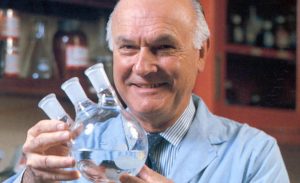 An inventor might set out to solve a problem or make a job easier, but halfway through the process…somehow, the invention turns into something completely different. And some inventions maybe started out simply experimenting with different chemicals and suddenly, you have something amazing.
An inventor might set out to solve a problem or make a job easier, but halfway through the process…somehow, the invention turns into something completely different. And some inventions maybe started out simply experimenting with different chemicals and suddenly, you have something amazing.
Eastman Kodak researcher, Harry Coover was trying to create plastic gunsights. Coover first came across cyanoacrylates (the chemical name for these überadhesives) in World War II. The problem was that the cyanoacrylates kept sticking to everything. The substance they came up with was very sticky. In fact, it was so sticky that it just wouldn’t work.  Its stickiness infuriated Coover. The substance was “shelved” for years, because while it was an interesting substance, they couldn’t figure out what to use it for.
Its stickiness infuriated Coover. The substance was “shelved” for years, because while it was an interesting substance, they couldn’t figure out what to use it for.
Coover dismissed the chemical and tried different approaches. He came across the material again in 1951. This time, Kodak experimented with cyanoacrylates for heat-resistant jet airplane canopies. Again, the stickiness got in the way. It wouldn’t work for the project at hand, but then Coover had an epiphany. “Coover realized these sticky adhesives had unique properties in that they required no heat or pressure to bond,” writes the Massachusetts Institute of Technology (MIT) in a column from 2004. “He and his team tried the substance on various items in the lab and each time, the items became permanently bonded together. Coover – and his employer – knew they were on to something.” This stuff was an amazing adhesive.
While Coover’s original patent called the new invention “Superglue,” Kodak sold the adhesive under the less-evocative name “Eastman 910.” Have you ever heard of Eastman 910? No…I haven’t either. Sometimes the  success of an invention is partly or even largely in the name. Eastman 910 was a very good adhesive, but with a lackluster name. “Later it became known as Super Glue, and Coover became somewhat of a celebrity, appearing on television in the show ‘I’ve Got a Secret,’ where he lifted the host, Garry Moore, off the ground using a single drop of the substance,” writes MIT. I doubt there are many people these days who haven’t heard of Superglue. We have all used it, because it is one of the best glues out there. As the years go by, I’m sure inventors will come up with better glues, but I don’t know if any of them will be as easy to use as Superglue is.
success of an invention is partly or even largely in the name. Eastman 910 was a very good adhesive, but with a lackluster name. “Later it became known as Super Glue, and Coover became somewhat of a celebrity, appearing on television in the show ‘I’ve Got a Secret,’ where he lifted the host, Garry Moore, off the ground using a single drop of the substance,” writes MIT. I doubt there are many people these days who haven’t heard of Superglue. We have all used it, because it is one of the best glues out there. As the years go by, I’m sure inventors will come up with better glues, but I don’t know if any of them will be as easy to use as Superglue is.
 In this technological age, everyone has heard of the internet…even those who don’t know how to use it. It is thought to be the most advanced way to access information, and that is true. People don’t have to even leave their homes to have access to information, products, email, or media…even social media. It was an amazing invention, and some might say it was a time hog. It was the invention of all time, but…it wasn’t the first of it’s kind.
In this technological age, everyone has heard of the internet…even those who don’t know how to use it. It is thought to be the most advanced way to access information, and that is true. People don’t have to even leave their homes to have access to information, products, email, or media…even social media. It was an amazing invention, and some might say it was a time hog. It was the invention of all time, but…it wasn’t the first of it’s kind.
On October 29, 1969, the Advanced Research Projects Agency Network (ARPANET) an early packet-switching network and the first network to implement the TCP/IP protocol suite was presented. Both of those technologies became the technical foundation of the Internet. The ARPANET was initially founded by the Advanced Research Projects Agency (ARPA) of the United States Department of Defense. It seems fitting to me that the Department of Defense would be the first ones to access such instantaneous information sources. Many people and even government agencies might have thought that the average person had no need to be able to access such information, but that would be wrong. Now it’s vital.

Paul Baran, Donald Davies, Leonard Kleinrock, and Lawrence Roberts came up with the concepts, and designed the packet-switching methodology employed in the ARPANET. The TCP/IP communications protocols were developed for the ARPANET by Robert Kahn and Vint Cerf. They also incorporated concepts from the French CYCLADES project directed by Louis Pouzin. As the network development progressed, protocols for internetworking were developed by which multiple separate networks could be joined into a network of networks. Access to the ARPANET was expanded in 1981, when the National Science Foundation (NSF) funded the Computer Science Network (CSNET). In 1982, the Internet protocol suite (TCP/IP) was introduced as the standard networking software stack in the ARPANET. In the early 1980s, the NSF funded the establishment of national supercomputing centers at several universities, and provided network access and network interconnectivity with the NSFNET project in 1986. The ARPANET project was formally decommissioned in 1990,  after partnerships with the telecommunication industry paved the way of future commercialization of a new world-wide network…the Internet.
after partnerships with the telecommunication industry paved the way of future commercialization of a new world-wide network…the Internet.
I’m sure that, like the pre-windows DOS program, the ARPANET was quite a bit more primitive. Still, it was an amazing thing to be able to connect with people who were a good distance away from you, and pass data along to them. Of course, the only ones who had access were those in the network, but then when you think about it, if you don’t have internet access, you are out of the loop too, so I guess it is no different really. Most of us thought that the internet was a unique invention, but in reality, it was second in line.
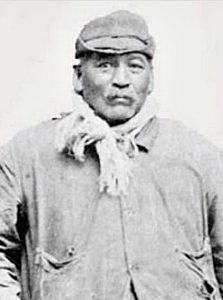 I suppose that most of the time, when someone sets out to invent something, they have a specific plan in mind, but maybe not. A number of inventors were trying to invent something completely different from what they ended up inventing, or they weren’t trying to “invent” anything at all, but ended up making something very cool.
I suppose that most of the time, when someone sets out to invent something, they have a specific plan in mind, but maybe not. A number of inventors were trying to invent something completely different from what they ended up inventing, or they weren’t trying to “invent” anything at all, but ended up making something very cool.
One day in 1853, a chef at the Carey Moon Lake House in Saratoga Springs, New York, named George Crum was at work, and making a meal for a customer. Apparently this customer was rather picky, which I can understand when it comes to certain things. The customer had ordered a plate of fried potatoes, and since my mom, Collene Spencer often made fried potatoes when I was a kid, I can attest to how great they tasted. Fried potatoes, however, must be correctly cooked to be really good, and I suppose that there are many differing views as to which way of cooking them is correct. Sometimes, its just a matter of personal preference.
Chef Crum fried the potatoes in the way he had always done so, but found that he was apparently unable to please this particular customer. Anyone who has ever worked in a restaurant knows that it is really frowned upon to have food sent back to the kitchen. The chef is given a goal of almost reading the mind of the customer…and expected to get it right. I know that this can be difficult from my own experience. I love what I would call extra crispy bacon, but when I tell them extra crispy, I usually end up with bacon that is floppy and, in my opinion, disgusting. I have long since learned that if I want to get truly crispy bacon, I must tell them that I want it burned. Only then will the bacon come out “crispy” enough for me, which, by the way, never has any black parts that would indicate that it was burned.
On this particular day, Chef Crum was having a bad day, at least from the perspective of pleasing the  customer, who sent the potatoes back many times, asking that the potatoes be thinner and crispier. Finally in a fit of temper, Chef Crum sliced the potatoes insanely thin and fried them until they were “as hard as a rock,” before sending them back out to the customer. To his astonishment, the customer absolutely loved the potatoes, and wanted more. Now, for anyone who likes potato chips, the request for seconds comes as no surprise, because it really is hard to eat just one potato chip, as the saying goes. Since that day, I’m sure that these new fangled potatoes were a menu favorite at the Carey Moon Lake House. They must have been, because as we all know, they are still available to this day, and they show no sign of losing their popularity now either.
customer, who sent the potatoes back many times, asking that the potatoes be thinner and crispier. Finally in a fit of temper, Chef Crum sliced the potatoes insanely thin and fried them until they were “as hard as a rock,” before sending them back out to the customer. To his astonishment, the customer absolutely loved the potatoes, and wanted more. Now, for anyone who likes potato chips, the request for seconds comes as no surprise, because it really is hard to eat just one potato chip, as the saying goes. Since that day, I’m sure that these new fangled potatoes were a menu favorite at the Carey Moon Lake House. They must have been, because as we all know, they are still available to this day, and they show no sign of losing their popularity now either.
 This year marks the 82nd anniversary of the invention of nylon. For most of us, this invention was life-changing, whether we realize it or not. This invention was more than just the stockings or pantyhose that most of us think about, because nylon is in much more than that. It is used to make toothbrushes, umbrellas, hair brushes, fishing line, windbreakers, camping tents, winter gloves, kites, dog leashes, dog collars, guitar strings, guitar picks, children’s toys, racket strings, and medical implants, just to name a few of the nearly innumerable things made from nylon. People have Wallace Carothers and his team at DuPont to thank for it.
This year marks the 82nd anniversary of the invention of nylon. For most of us, this invention was life-changing, whether we realize it or not. This invention was more than just the stockings or pantyhose that most of us think about, because nylon is in much more than that. It is used to make toothbrushes, umbrellas, hair brushes, fishing line, windbreakers, camping tents, winter gloves, kites, dog leashes, dog collars, guitar strings, guitar picks, children’s toys, racket strings, and medical implants, just to name a few of the nearly innumerable things made from nylon. People have Wallace Carothers and his team at DuPont to thank for it.
The inspiration for nylon really came during the Great Depression. Women have always loved soft stockings, and at that time, silk was very expensive, and most women couldn’t afford them. So, by the mid-30s, several DuPont Chemicals scientists led by Wallace Carothers were secretly working on a prototype polymer known then as “fiber 6-6,” which is another name for nylon.
Though nylon was first synthesized in a DuPont Chemicals laboratory on February 28, 1935, it didn’t become available to the public until 1940. When it did, it was in the form of stockings, and women across the United States flocked to department stores to get their hands on a pair. While silk probably felt more luxurious, the cost of it made it impossible to get, so nylon stockings became a great alternative, and when I think about my Aunt Gladys silk stockings, and how as little girls, my sisters and I couldn’t resist the feel of them. All Aunt Gladys ever said was to be careful not to snag them. I think that most people would be seriously worried about them, simply because of the cost. I often wonder if she was secretly cringing over the whole situation.
Dupont thought about going into other lines of products, but with the money they were making on the women’s 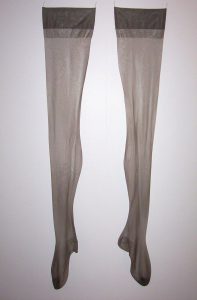 stockings bringing in in $9 million for DuPont in 1940, or $150 million in today’s dollars. They were pretty much the exclusive line at that time. Nevertheless, despite its wildly successful first year, DuPont shifted nearly all of its nylon production from the consumer market to the military in 1941 as the United States entered World War II. Allied forces used the material for everything from parachutes to mosquito nets.
stockings bringing in in $9 million for DuPont in 1940, or $150 million in today’s dollars. They were pretty much the exclusive line at that time. Nevertheless, despite its wildly successful first year, DuPont shifted nearly all of its nylon production from the consumer market to the military in 1941 as the United States entered World War II. Allied forces used the material for everything from parachutes to mosquito nets.
By then, fashion trends had already spurred such high demand for the stockings that when consumers couldn’t get their hands on them, a sort of black market emerged. Some women even resorted to painting their legs in an effort to capture the look. When the war ended and production returned to pre-war levels, women rushed to department stores. They waited in lines that made early day Black Friday lines seem small by comparison, and sometimes even resulted in violent chaos. The phenomenon came to be known as the nylon riots. One of the most notable examples occurred in Pittsburgh in 1945, where 40,000 women lined up to try to snag a pair of nylons.
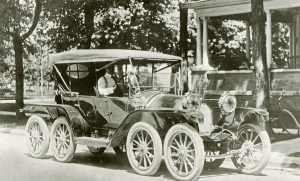
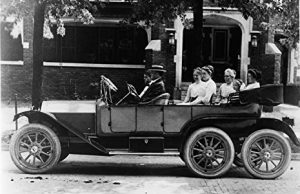 With the invention of the automobile, came the need to make improvements on things like speed, reliability, and looks. Most of the improvements that were made seemed to make sense and improved the automobile, but its been said that, “The line between visionary or eccentric, between progressive thinking, and outright insanity is often quite thin.” During the years when the American automobile industry was rapidly forming, the “unbridled manifestations of a creative imagination” blurred that line on thousands of occasions.
With the invention of the automobile, came the need to make improvements on things like speed, reliability, and looks. Most of the improvements that were made seemed to make sense and improved the automobile, but its been said that, “The line between visionary or eccentric, between progressive thinking, and outright insanity is often quite thin.” During the years when the American automobile industry was rapidly forming, the “unbridled manifestations of a creative imagination” blurred that line on thousands of occasions.
One such “blurring” involved the number of wheels on a automobile. Oddly, that is something that is still under debate today, with the dually pickup. I guess I can see how four wheels on the rear of a vehicle, set side by side, might give more traction, but some of the extra wheels designs of the vehicles in the past, simply made no sense to me. One of the more eccentric of those designs was the eight-wheeled Octoauto. It sported an astounding 180-inch wheelbase. Another example was the six-wheeled Sextoauto, devised by Milton O. Reeves. At the very least, these cars were goofy looking, and the designs seemed to have no exact reason or purpose for the placement of the wheels.
Another example, of the visionary side of the inventive line would be the optional swing away, electrically heated steering wheel available on the 1917 McFarlan. I guess I can see the value in that, especially on a cold winter day. There is nothing worse than toughing a freezing cold steering wheel, except maybe a burning hot one. Benjamin Briscoe of the Jackson, Michigan, based at Briscoe Motor Corporation, straddled the line quite nicely when he built the 1914 models. The 1914 models sported a single Cyclops headlight mounted dead center in the upper radiator shell and laminated paper-mâché body panels…that’s right, I said paper-mâché. The 1916 models sold with four cylinder engines and a promotion proclaiming, “Buy the Four. Use it a month. If then you decide you want the Eight, simply pay the difference and a small installation fee.” Sometimes, what appears to be eccentric today was innovative technology during the first decades of the industry. Promoted as, “The Friction Drive Car” was the 1907 Lambert, a vehicle that served to pioneer the type of transmission capitalized on with the patented developments of Byron Carter.
Between the creation of the first experimental models by William Lambert in 1891 and the companies’ closing in 1917, a wide array of “interesting” vehicles rolled from the companies manufacturing facilities in Anderson, 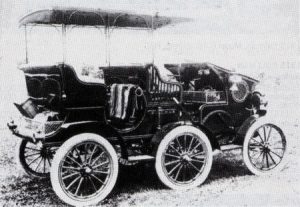
 Indiana. They had engines mounted in the rear, the front, or middle, and came in two-cylinder and four-cylinder configuration, providing power to one or two wheels, dependent on if it were a three-wheel or four-wheel model. I’m sure that along the way there were a number of other interesting and even strange ideas concerning the automobile, but I guess that’s progress, and some of them weren’t progress at all, but a step backward.
Indiana. They had engines mounted in the rear, the front, or middle, and came in two-cylinder and four-cylinder configuration, providing power to one or two wheels, dependent on if it were a three-wheel or four-wheel model. I’m sure that along the way there were a number of other interesting and even strange ideas concerning the automobile, but I guess that’s progress, and some of them weren’t progress at all, but a step backward.

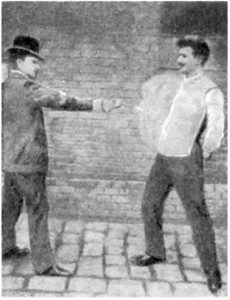 Every new invention has to have its trial run, but some of them might not be so easy to test as others. If you are testing a Frisbee to see if it flies, it is much different than testing a plane to see if it flies. Still, an invention cannot be used, sold, and especially patented without being tested, so testing must be done, and sometimes that can be a little bit dangerous.
Every new invention has to have its trial run, but some of them might not be so easy to test as others. If you are testing a Frisbee to see if it flies, it is much different than testing a plane to see if it flies. Still, an invention cannot be used, sold, and especially patented without being tested, so testing must be done, and sometimes that can be a little bit dangerous.
For many years, police work was extremely dangerous…even more so than it is now. Without some of the protective coverings the officers have today, they could be easily killed in the line of duty…not that they can’t now, but there is a little bit less chance of it these days. Kazimierz Zeglen, was a Polish engineer, born in 1869 near Ternopol. He is credited with inventing the first bulletproof vest. In 1893, after the assassination of Carter Harrison Sr, the mayor of Chicago, he invented the first commercial bulletproof vest. In 1897, he improved it together with Jan Szczepanik who was the inventor of the first commercial bulletproof armor in 1901. It saved the life of Alfonso XIII, the King of Spain…his carriage was covered with Szczepanik’s bulletproof armor when a bomb exploded near it.
When the time came to test the bullet proof vest, a man names Mr Borzykowski, who was a friend of Szczepanik, agreed to test the vest…not on himself, mind you, but on his servant. When he shot his servant, it looks to me like the man braced for death, but he stood in place as he was told to do. It’s kind of like testing a shark suit for the first time. You would have no idea if you would see tomorrow or not. Once the vest was tested, however, it quickly became a valued piece of protective gear for police officers everywhere. The vest worked very well, but the early vests were quite heavy. Through the years, vests have much improved, and will continue to do so, as new materials become available.
When a new lighter vest was demonstrated by the Protective Garment Corporation of New York in 1923, it had to be proven again, because no one was willing to buy these vests sight unseen, so to speak. The gun players were WH Murphy and his assistant. Pictures were taken during a demonstration of the company’s bulletproof vest for DC area police. The live demonstration took place at the Washington city police headquarters. The inventors and salesmen were trying to convince the police force that these bulletproof vests did work and did save lives. The police officers in the background were all part of the Frederick County Police Department, the gun they were firing is believed to be a Smith and Wesson Model 10 Revolver. Mr 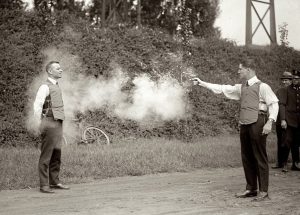
 Murphy stood less than ten feet from the firing gun and took two consecutive .38 round slugs straight to the chest. An eye witnesses claims he “didn’t bat an eye” in both cases. Later Murphy gave the deflected .38 bullet to the police officer as a souvenir. This vest weighed 11 pounds, fit close to the body, and was considered more comfortable than the previous types of bulletproof vests. The bullet proof vest has become standard gear for police officers.
Murphy stood less than ten feet from the firing gun and took two consecutive .38 round slugs straight to the chest. An eye witnesses claims he “didn’t bat an eye” in both cases. Later Murphy gave the deflected .38 bullet to the police officer as a souvenir. This vest weighed 11 pounds, fit close to the body, and was considered more comfortable than the previous types of bulletproof vests. The bullet proof vest has become standard gear for police officers.
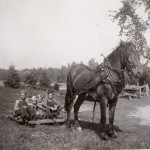 I love the way that kids can be so inventive. They have some great ideas, and while they can’t always make their ideas into reality by themselves, with a little help, you will find that they will get it done. No one really knows who created the skate board, but it was designed by attaching wheels from a pair of skates to create a surfing effect. That way they could surf, even if the ocean waves weren’t cooperating. A good idea if you ask me.
I love the way that kids can be so inventive. They have some great ideas, and while they can’t always make their ideas into reality by themselves, with a little help, you will find that they will get it done. No one really knows who created the skate board, but it was designed by attaching wheels from a pair of skates to create a surfing effect. That way they could surf, even if the ocean waves weren’t cooperating. A good idea if you ask me.
Then there were the go carts. Made from things in the garage, they were usually wooden and used the wheels off of a tricycle or some such item. Of course, I would expect that the brakes took a little more figuring. I’m sure those first go carts ended in crashes more than they didn’t, and eventually someone found a way to make them stop. If they hadn’t, I think they would have stopped riding them after a while, since there is only so much crashing a person can take before they decide that this just isn’t worth the ride.
What I find very interesting, is the types of things the kids back in my parents’ day did when they wanted to create a new mode of transportation. It would appear to me that they were trying to make a sleigh, and they had no wheels…or snow, for that matter. I would imagine that it was a bumpy ride to say the least, but them these boys don’t seem to mind that thought much. I’m quite sure they were very proud of their new contraption. It also makes me think of the many kids these days, who have done their very best to hook their dog up to a wagon and have the dog pull them around. While that might work ok with a dog, I’m not so sure I would want to try it with a horse, but then, I don’t know that particular horse, and they surely did. It is quite possible that the horse knew the typical antics these boys pulled, and like any pet, who loves it’s master, the horse was gentle enough to go along with the new fangled vehicle that was hooked up to it.

